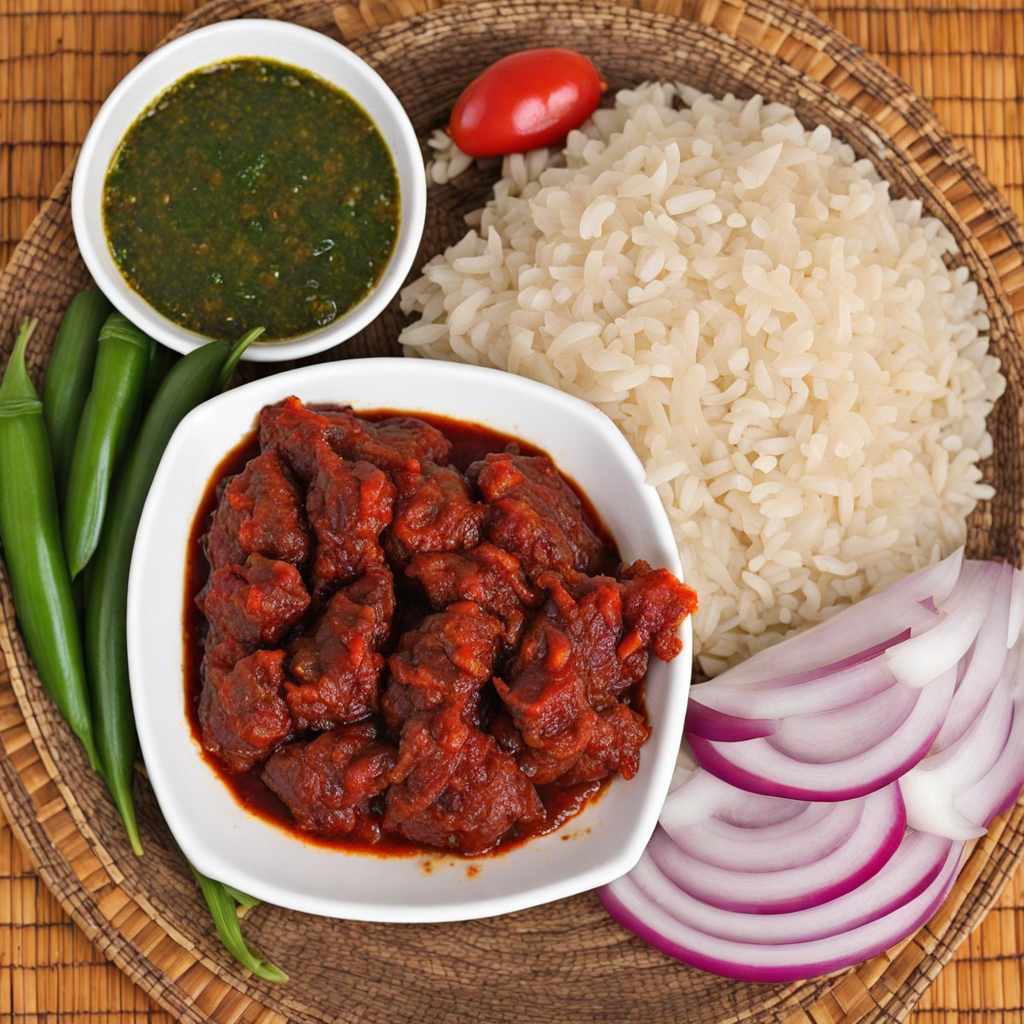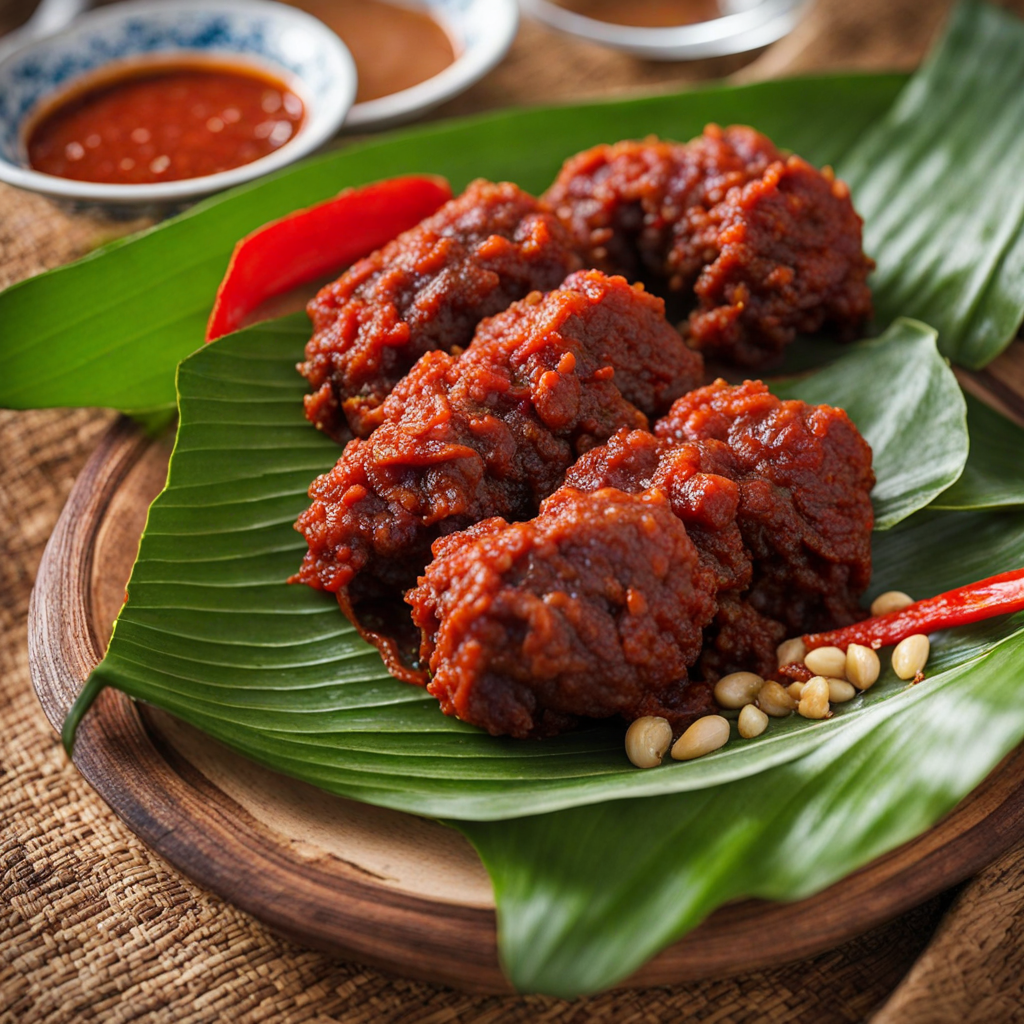Sambal
Sambal is a vibrant and spicy condiment that originates from the rich culinary traditions of Sudan. This flavorful sauce is primarily made from a blend of fresh chili peppers, garlic, and various spices, creating a fiery yet aromatic experience. The base of sambal often includes ingredients such as tomatoes, onions, and vinegar, which contribute to its distinctive tangy and savory notes. Its deep red color is visually striking, inviting adventurous eaters to dive into its bold flavors. Each region in Sudan may have its own twist on sambal, with variations that cater to local tastes and available ingredients, making it a versatile addition to many dishes.
How It Became This Dish
The History of سنبل (Sunbul) in Sudan: A Culinary Journey In the heart of Sudan, where the Nile’s fertile banks meet the arid expanses of the desert, lies a tapestry of rich cultural traditions woven over centuries. Among the myriad of culinary delights that characterize Sudanese cuisine, سنبل (Sunbul), or what is often referred to as "Sudanese anise," stands out for its unique flavor profile and deep-rooted significance in the local culture. This essay delves into the origins, cultural significance, and development of سنبل within Sudan, tracing its path through history and its role in contemporary society. Origins of سنبل سنبل (Sunbul) is derived from the seeds of the plant *Pimpinella anisum*, commonly known as anise. Though its precise geographic origin is debated, it is widely believed to have been cultivated in the Mediterranean region, with historical texts suggesting its use dating back to ancient Egyptian times. The plant traveled through trade routes, finding its way to the Arabian Peninsula and eventually into the heart of Sudan, where it adapted to the local soil and climate. In Sudan, سنبل has been an integral part of the agricultural landscape, thriving in the country’s diverse ecosystems. The Sudanese people began cultivating سنبل not only for its culinary uses but also for its medicinal properties, as anise has long been associated with aiding digestion and providing relief from various ailments. The incorporation of سنبل into Sudanese cooking reflects a blend of indigenous practices and the influences of neighboring cultures, including Arab, African, and Mediterranean culinary traditions. Cultural Significance سنبل is more than just a spice in Sudan; it embodies the essence of Sudanese hospitality and community. Traditionally, سنبل is used in a variety of dishes, most notably in the preparation of sweet and savory dishes alike. It is commonly found in traditional Sudanese bread, where its aromatic qualities enhance the flavor, and in beverages, particularly in sweet teas served during social gatherings. The infusion of سنبل in these recipes signifies the warmth of Sudanese hospitality, as sharing food is a vital part of social interactions. Moreover, سنبل holds significant cultural associations during religious and festive occasions. In Sudanese culture, the preparation of special dishes using سنبل during Ramadan or weddings speaks to the spice’s role in marking important life events. The aroma of سنبل wafting through homes during these times evokes a sense of nostalgia and togetherness, creating lasting memories for families and communities. Development Over Time As Sudan navigated through various historical and political changes, the role of سنبل evolved alongside the broader shifts in culinary practices. The colonial period introduced new agricultural techniques and crops, but traditional ingredients like سنبل remained resilient, adapting to modern cooking methods while retaining their cultural essence. In the latter half of the 20th century, the globalization of food and increased access to international markets led to a newfound appreciation for Sudanese cuisine, including the use of سنبل. Chefs and food enthusiasts began to explore traditional Sudanese recipes, incorporating سنبل into contemporary dishes, thus revitalizing its presence in both local and international culinary scenes. The rise of the internet and social media platforms has further amplified the visibility of سنبل and Sudanese cuisine. Food bloggers and influencers have shared recipes that highlight the use of سنبل, bridging generational gaps and fostering a renewed interest in traditional Sudanese culinary practices. This resurgence has encouraged younger generations to embrace their heritage, ensuring that the legacy of سنبل continues to thrive. Contemporary Uses and Global Influence Today, سنبل has transcended its traditional boundaries, finding its way into the kitchens of food lovers around the world. Chefs, influenced by global culinary trends, have begun to experiment with سنبل, incorporating it into fusion dishes that marry Sudanese flavors with global cuisines. Its distinct flavor profile has found a place in modern gastronomy, appealing to those seeking unique and aromatic ingredients. In Sudan, the culinary landscape continues to evolve as local chefs and home cooks experiment with سنبل in innovative ways. Contemporary Sudanese cuisine often features fusion elements, where سنبل is used in unexpected applications, such as in desserts, cocktails, and gourmet dishes. This creativity not only honors the tradition but also showcases the versatility of سنبل as a culinary ingredient. Conclusion The history of سنبل in Sudan is a testament to the resilience of traditional culinary practices in the face of modernity. From its origins in ancient agricultural practices to its role in contemporary Sudanese cuisine, سنبل has maintained its cultural significance while adapting to changing tastes and global influences. It symbolizes more than just a flavor; it represents a connection to heritage, community, and the enduring spirit of Sudanese hospitality. As the world continues to embrace the richness of diverse cuisines, سنبل stands as a flavorful ambassador of Sudanese culture, inviting people to explore the unique and aromatic traditions that have shaped the culinary identity of this vibrant nation. Through the lens of سنبل, we not only taste the past but also celebrate the present and future of Sudanese food culture, ensuring that it remains a cherished part of the global culinary narrative.
You may like
Discover local flavors from Sudan







